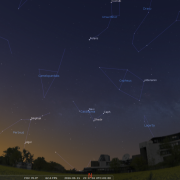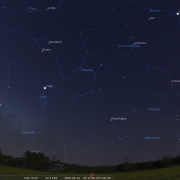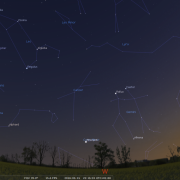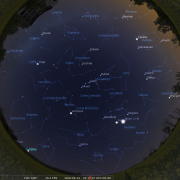In this month's Sky Notes:
Planetary Skylights
Three major planets are now visible in the late evening sky, Jupiter, Mars and Saturn.

 Jupiter resides in the SW as twilight deepens, an unmistakable ‘brilliant star’. Throughout June it continues to descend toward the West horizon, setting shortly before midnight. The moon lies below Jupiter on the 11th.
Jupiter resides in the SW as twilight deepens, an unmistakable ‘brilliant star’. Throughout June it continues to descend toward the West horizon, setting shortly before midnight. The moon lies below Jupiter on the 11th.
 Having just reached opposition, Mars remains a conspicuous object low to the South. The pale orange hue gives Mars away, although beware not to confuse the bright star Antares (chief star in Scorpius) which resides lower left, with the red planet. Through a telescope some surface detail is visible when ‘seeing’ allows, ie the image is stable, and so patience is required. The moon passes by Mars on the 16th and 17th.
Having just reached opposition, Mars remains a conspicuous object low to the South. The pale orange hue gives Mars away, although beware not to confuse the bright star Antares (chief star in Scorpius) which resides lower left, with the red planet. Through a telescope some surface detail is visible when ‘seeing’ allows, ie the image is stable, and so patience is required. The moon passes by Mars on the 16th and 17th.
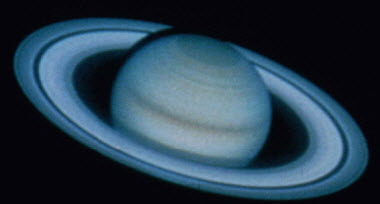
Hubble image of Saturn, taken by Hubble on 20-Nov-1990
at a distance of 1.39bn km (860 million miles).
 Saturn also resides low to the south, to the left of Mars, coming to opposition on the 3rd of June. It will then be visible all night, although at this time of year night is pretty short. Appearing similar in brightness to Mars, the pearly white lustre contrasts well with ‘ruddy’ Mars. You will require a telescope to observe the ring system, but it is a view worth every penny of buying a scope if you don’t already own one. Look for the Cassini gap in the rings as well as several moons nearby. Titan, Saturn’s largest moon appears as a bright speck close by, orbiting anticlockwise twice a month. Our Moon resides above Saturn on the 18th.
Saturn also resides low to the south, to the left of Mars, coming to opposition on the 3rd of June. It will then be visible all night, although at this time of year night is pretty short. Appearing similar in brightness to Mars, the pearly white lustre contrasts well with ‘ruddy’ Mars. You will require a telescope to observe the ring system, but it is a view worth every penny of buying a scope if you don’t already own one. Look for the Cassini gap in the rings as well as several moons nearby. Titan, Saturn’s largest moon appears as a bright speck close by, orbiting anticlockwise twice a month. Our Moon resides above Saturn on the 18th.
Meteor Showers

The weak Ophiuchid meteor shower has two maxima, June 9th and June 20th. The zenith hourly rate (ZHR) barely exceeds sporadic levels (5 - 8 per hr) Observe post midnight. The poorly observed June Lyrids peak on the 15th/16th, again the ZHR is only 5-6 per hour.
June 2016 Sky Charts
Click each image to see a full-size Sky Chart:
|
Looking South
Mid-June - 23:00h |
Looking North |
|
Looking East
Mid-June - 23:00h |
Looking West
Mid-June - 23:00h |
|
|
|
|
Overview
9th-June - 23:00h |
|
Additional Image Credits:
- Planets and Comets where not otherwise mentioned: NASA
- Sky Charts: Stellarium Software
- Log in to post comments



